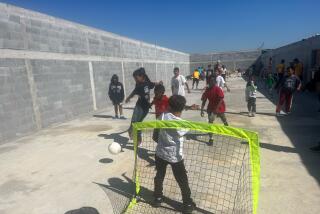Immigrants at School Tread New Ground in Lessons on American Life
- Share via
NEW YORK — “Coming to America was exciting at first,” said Ruslan Koss. “Then the reality set in. One day I was a veterinarian; the next, I was working in a warehouse selling auto parts.”
The reality is a fundamental fact of immigration.
Koss immigrated to Brooklyn four years ago from Odessa, his home in the Ukraine where he was educated. At 27, he’s a bit old for a college student on the American educational track, but that is what he is.
He’s in his third year at the Brooklyn extension center of Mercy College, one of a number of highly educated immigrants who have chosen to swallow hard, struggle hard and study hard to make a new life in the United States. He now has every expectation of running his own veterinary hospital.
Mercy College, which began as a tiny Catholic school for women half a century ago, has itself found a new life.
It moved into the forefront of higher education for immigrants during the influx of expatriate Cubans in the 1960s, became a nondenominational independent college in the ‘70s and has become a bulwark of adjustment for the tidal wave of immigration of the ‘90s.
From its original campus in nearby Dobbs Ferry, it has added two more suburban campuses and established eight extension centers scattered throughout New York’s urban neighborhoods. They accommodate an array of nationalities from every continent. Mercy’s “nontraditional” college students, as they are called, now number 700, half the enrollment.
“We come from places where we had to fight for everything,” says Eva Spinelli. “We grew up learning how to survive on ice.”
Spinelli is Mercy’s program director. Like most of the faculty, she can readily identify with her students. At 21, Spinelli, like Koss, fled the Ukraine. That was in 1945; she was later reunited with her parents in New York. Even without knowing English, she managed to get hired as a lab technician at a hospital. There, she says, she acquired two things that enabled her to make it in the United States: English and a husband.
“Having freedom is a great responsibility,” Spinelli says. “If you choose to live in America, you have to learn it.”
Spinelli speaks half a dozen languages. One thing she regrets, she says, is that her own three children speak only English.
“We want our students and their children to retain their native language while learning English. Who knows how valuable it might be 10 or 12 years from now if an American could speak, say, Russian as well as English.”
Spinelli says Mercy makes a continuing effort to recruit faculty members who are immigrants, went on to get their degree, or degrees, and have firsthand knowledge of what the students are going through.
“It’s amazing to me that I’m teaching people who’ve lived through some of the most terrifying events in history,” says Stark Whitley, a history lecturer--amazing, because Whitley, who was educated at Columbia University in New York City and Johns Hopkins University in Baltimore, teaches an introductory course on European history.
At the extension center in Brooklyn, it is evident that they are icily serious about getting an education. You will rarely see a slouched, daydreaming student.
Just minutes after eight buses go roaring up to Public School No. 62, hundreds of students disembark, frantically grab their schedules and head to class. At 7:30 p.m., the frenzy of arrival abruptly subsides. The subdued hallways lead to classrooms where something explosively inspirational is in progress.
Four nights a week, about 350 immigrants descend on the Brooklyn extension center to learn English and other essentials--how to fill out a lease, a resume, a job application.
Most of them, roughly 250, are Russian. About 60 are Polish and 40 Dominican. Most come directly from their daytime jobs. Some commute 90 miles. Few will allow themselves to feel tired; their minds are on learning a new alphabet and conjugating verbs.
The first semester or two is spent learning English as a second language. That done, they go on to regular college courses: sociology, psychology, accounting, computers. They also attend lectures on American culture and American medicine.
“This is about becoming Americanized, reclaiming our identities,” says Faelya Shleyfman, a former medical researcher in Kiev, Ukraine.
Inside the 42 classrooms are others like Shleyfman and Koss: highly educated individuals who had respectable careers in their native countries. Educators, economists, doctors, musicians, lawyers and business people once preoccupied with their professional agendas sit in front of a chalkboard reciting their ABCs.
Their backgrounds vary, but they all share a determination to survive.
Almost all of those attending the Brooklyn extension center are reminded of that responsibility each time they occupy the classrooms their children, nephews, nieces, or grandchildren attend during the day.
Although they are glad to be far from their troubled homelands, they’re also fraught with stories of personal pain. They are frightened about what the future holds for them.
“The prospects are grim,” Spinelli says. “They aren’t given a chance to get established. They’re discouraged. Before they were just frustrated. But this is the first year I’ve seen the students depressed.”
The reason, she says, is because of uncertainty about the future of welfare and educational aid.
Tuition at the three main campuses is $3,300; at an extension center, $2,200. The flat fee is the same whether they take 12 credits or 18.
“They are required to work 52 hours every two weeks to qualify for welfare,” she says. “For many who have families, it’s too much. They’re discouraged. They aren’t able to get established.
“Many of them feel they’ll be on welfare forever if they can’t get the knowledge to get a good job.
“This program is unique because it’s designed so people can get off welfare. We went into the neighborhood, accommodated them by busing them to the extension center so they can get here. And we give them courses that are associated with how to survive in America and teach them English.”
Most students pay out-of-pocket or with a government grant. Often the college itself makes grants, especially if a student works toward a bachelor’s degree after receiving an associate degree. Some take a break from studies for a semester to save money. But most return to complete their course work, Spinelli says.
Regardless of the language difficulties and cultural adjustments, many who have instructed the students say they will make it because they need to.
“They’re here more for their children’s sake. They want to expand their opportunities,” says Gloria Yulansky Catanzako, a teacher.
“They realize there is no future for their kids if they aren’t willing to learn this culture and language,” she says.
Catanzako helps students read rental and car-sale ads, fill out leases, job applications and health benefits forms, and advises them on job searches.
She says that for many of these people who are from countries where the governments told them what to do, education is providing them greater independence. “Here they learn how to empower themselves,” she says.
For many, Mercy is more than an academic institution.
Ida Berezovskaya and Florida Khutorotskaya, both in their 60s, had not seen each other since they were teenagers in Kiev. It was not until they were sitting next to each other in English class that they discovered they were second cousins.
“I’m very happy,” says Berezovskaya, throwing her arms around Khutorotskaya.
Veterinarian Koss cites reasons that are more down-to-earth:
“I know in America there’s equal opportunity,” he says. “If you work hard, you can get whatever you want. That’s something new to us immigrants. That gives us hope.”
More to Read
Sign up for Essential California
The most important California stories and recommendations in your inbox every morning.
You may occasionally receive promotional content from the Los Angeles Times.










